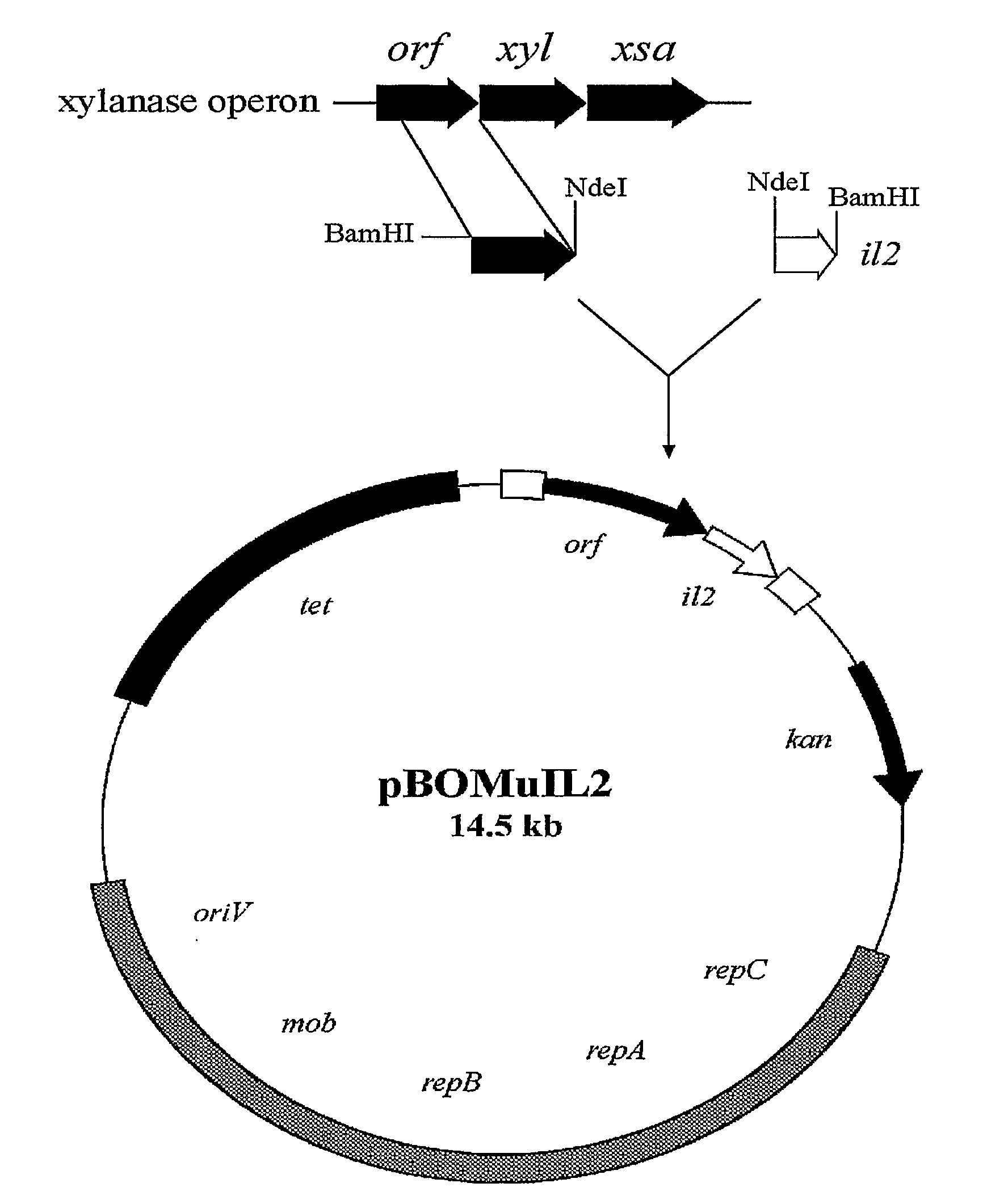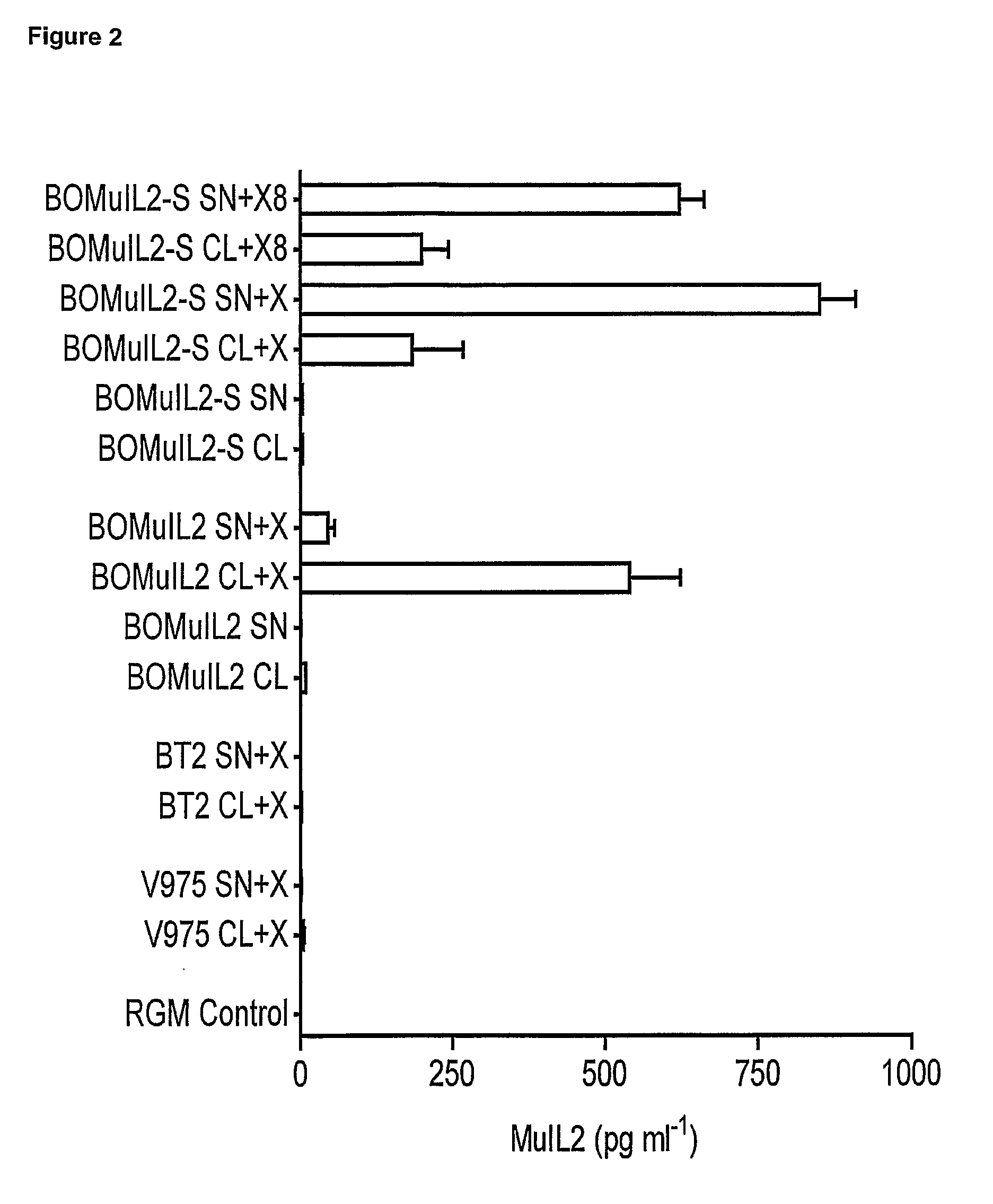Controlled Production and Delivery of Biologically Active Agents by Gut Bacteria
a technology of gut bacteria and biological active agents, which is applied in the direction of biocide, plant growth regulators, biochemistry apparatus and processes, etc., can solve the problems of limited success evidence, adverse side effects, toxicity and immunosuppression, etc., and achieve the effect of avoiding inconvenience and systemic exposure and being convenient and simpl
- Summary
- Abstract
- Description
- Claims
- Application Information
AI Technical Summary
Benefits of technology
Problems solved by technology
Method used
Image
Examples
example 1
[0051]A study was undertaken to assess the ability to colonise the mouse intestine of the genetically engineered strain of B. ovatus, B. ovatus-MuIL2, designed to produce the murine growth factor Interleukin-2 (IL-2) in the presence of xylan.
[0052]Since the utility of using B.ovatus-MuIL2 to treat IL2- / - mice is dependent upon demonstrating that it can colonise the mouse colon, we determined if B.ovatus-MuIL2 could colonise the colon of wildtype mice. Wildtype, specific pathogen free (SPF), C57BL / 6 mice, maintained on a conventional diet (containing xylan), were infected with a single inoculum of ˜1010 cfu B.ovatus-MuIL2 by oral gavage. Colonisation was evaluated 7, 14, 21 and 28 days later by culturing faecal pellets under anaerobic conditions in the presence of antibiotics permissive for the growth of all Bacteroides sp., or for the growth of B.ovatus-MuIL2 alone. In future experiments the identity of B.ovatus-MuIL2 in faecal cultures will be more extensively verified by colony fi...
example 2
[0053]A study was undertaken to assess the ability of the genetically engineered strain of B. ovatus, B. ovatus-MulL2, designed to produce the murine growth factor lnterleukin-2 (IL-2) in the presence of xylan to adversely affect the onset or severity of intestinal inflammation that spontaneously occurs in mice genetically deficient of IL-2 (IL-2- / - mice). A
[0054]concern in using commensal bacteria in immunotherapy protocols for IBD is that the chosen bacteria may, in immunocompromised animals and patients, be “pathogenic” and promote, amplify or sustain intestinal inflammation. Bacteroides, and in particular B. fragilis and B. vulgatis, have been associated with the development of intestinal inflammation in experimental animal models of IBD and in IBD patients. One study has also identified increased titres of IgA and IgG antibodies reactive with antigens of B. ovatus in the sera of IBD patients5. However, it is not clear if this was a cause of intestinal inflammation, or was secon...
example 3
[0056]To assess the production of MuIL2 by strains BOMuIL2 and BOMuIL2-S, recombinant strains (BOMuIL2, BOMuIL2-S and BT2) and the wild type strain (V975) were grown in medium with or without xylan. In addition, BOMuIL2 and BOMuIL2-S were grown for 16 h without xylan (RGM with glucose) followed by a further 8 h with xylan to demonstrate the inducible nature of production. Cell lysates and culture supernatants were assayed for MuIL2 by ELISA and bioassay. Representative results from 3 independent experiments are shown in FIG. 2, levels of MuIL2 in cell lysates (CL) and culture supernatants (SN) of B. ovatus BOMuIL2, B. ovatus BOMuIL2-S and control strains (V975 and BT2) grown with xylan for 24 h (+X) or without xylan. BOMuIL2-S was also grown without xylan for 16 h followed by 8 h with xylan (+X8). Test and control strains of B. ovatus were grown in RGM with or without xylan. Cells were harvested and lysed and the amount of MuIL2 in lysates and culture supernatants determined by ELIS...
PUM
 Login to View More
Login to View More Abstract
Description
Claims
Application Information
 Login to View More
Login to View More - R&D
- Intellectual Property
- Life Sciences
- Materials
- Tech Scout
- Unparalleled Data Quality
- Higher Quality Content
- 60% Fewer Hallucinations
Browse by: Latest US Patents, China's latest patents, Technical Efficacy Thesaurus, Application Domain, Technology Topic, Popular Technical Reports.
© 2025 PatSnap. All rights reserved.Legal|Privacy policy|Modern Slavery Act Transparency Statement|Sitemap|About US| Contact US: help@patsnap.com



